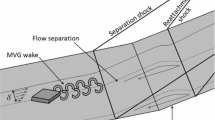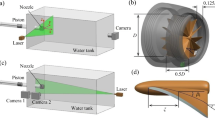Abstract
The flow control of a supersonic mixing layer was studied in a supersonic mixing layer wind tunnel with convective Mach number (Mc) at 0.5. The passive control of the mixing layer was achieved by perturbation tapes on the trailing edge of the splitter plate. The control effects of 2D and 3D perturbation tapes with different sizes were compared. The mixing layer was visualized via NPLS, and the transient fine structures were identifiable in NPLS images, which were used to analyze the effects of flow control. The results show that the 2D tapes can enhance the 2D characteristic of the mixing layer, delaying mixing layer transition; and the 3D tapes can enhance the 3D characteristic of the mixing layer, advancing mixing layer transition. 3D structures of the mixing layer were visualized, and the H-type Λ vortexes were found with 3D tapes control.
Similar content being viewed by others
References
Michalke A. On spatially growing disturbances in an inviscid shearlayer. J Fluid Mech, 1965, 23: 71–404
Brown G L, Roshko A. On density effects and large structures inturbulent mixing layer. J Fluid Mech, 1974, 64: 775–816
Knapp C F, Roache P J. A combined visual and hot-wire anemometer investigation of boundary layer transition. AIAA J, 1968, 6: 29–36
Sadham N D, Reynolds W C. Three-dimensional simulations of large eddies in the compressible mixing layer. J Fluid Mech, 1991, 224: 133–158
Zhou H, Zhao G F. Hydrodynamic Stability. Beijing: National Defense Industry Press, 2004
Gad-el-Hak M, Pollard A, Bonnet J-P. Flow Control: Fundamentals and Practices. Berlin: Springer, 1998. 335–429
Cao W, Zhou H. The enhancement of the mixing of a 2D supersonic mixing layer. Sci China Series A-Math Phys Astron, 2002, 32(2): 150–157
Sun M B, Wang Z G, Lang H. Mixing enhancement of a 2D supersonic mixing layer induced by inflow periodic temperature excitation. J Astronaut, 2008, 29(2): 444–448
Fan J C. Modern Flow Visualization. Beijing: National Defense Industry Press, 2002
Zhao Y X, Yi S H, Tian L F, et al. Nano-tracer planar laser scattering. Proceedings of the 13th national symposium on shock wave and shock tube technology. 2008, 323–330
He L. The design and experimental studies of supersonic straight through wind tunnel and “supersonic-supersonic” mixing layer wind tunnel. Dissertation for Master Degree. Changsha: National University of Defense Technology, 2006
Zhao Y X, Yi S H, He L, et al. The experiment study of interaction between shock wave and turbulence. Chin Sci Bull, 2007, 52: 1297–1031
Tian L F, Yi S H, Zhao Y X, et al. Flow visualization of supersonic around a concave optical bow cap model of warhead. J Exp Fluid Mech, 2009, 23: 15–17
Zhao Y X, Yi S H, He L, et al. The fractal measurement of experimental images of supersonic turbulent mixing layer. Sci China Ser G-Phys Mech Astron, 2008, 51: 1134–1143
Tian L F, Yi S H, Zhao Y X, et al. Study of density field measurement based on NPLS technique in supersonic flow. Sci China G-Phys Mech Astron, 2009, 52(9): 1357–1363
Zhao Y X. Experimental investigation of spatiotemporal structures of supersonic mixing layer. Dissertation for doctor degree. Changsha: National University of Defense Technology, 2008
Author information
Authors and Affiliations
Corresponding author
Rights and permissions
About this article
Cite this article
Yi, S., He, L., Zhao, Y. et al. A flow control study of a supersonic mixing layer via NPLS. Sci. China Ser. G-Phys. Mech. Astron. 52, 2001–2006 (2009). https://doi.org/10.1007/s11433-009-0301-0
Received:
Accepted:
Published:
Issue Date:
DOI: https://doi.org/10.1007/s11433-009-0301-0




